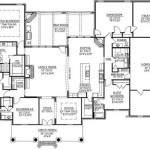Essential Aspects of Elderly Housing Floor Plans
As we age, our needs and preferences change, and our living spaces should reflect those changes. For elderly individuals, well-designed housing can make a significant difference in their quality of life, safety, and independence. When designing or choosing an elderly housing floor plan, it is essential to consider several key aspects to ensure a comfortable and supportive living environment.
1. Accessibility
Accessibility is paramount for elderly residents. Floor plans should prioritize ease of movement throughout the home, with wide hallways, doorways, and ramps or elevators to accommodate mobility aids such as wheelchairs or walkers. Thresholds should be minimized, and surfaces should be slip-resistant to prevent falls.
2. Safety Features
Safety is a crucial concern for elderly residents. Floor plans should incorporate safety features such as grab bars in bathrooms, non-slip flooring, and well-lit spaces to reduce the risk of accidents. Emergency call systems and smoke detectors should also be strategically placed for easy access.
3. Adaptability
As mobility and needs change over time, elderly housing should be adaptable to accommodate future adjustments. Floor plans should include flexible spaces that can be easily modified to meet changing requirements, such as adjustable countertops, accessible showers, and multi-use areas.
4. Universal Design
Universal design principles should be incorporated into elderly housing floor plans to create an inclusive and accessible environment for individuals with various abilities. This includes features such as lever handles, adjustable lighting, and contrasting colors to enhance visibility.
5. Efficient Space Utilization
Elderly housing floor plans should maximize space utilization without sacrificing accessibility or comfort. Compact layouts can reduce the need for excessive movement and create a more manageable living space. Storage solutions should be thoughtfully designed to keep frequently used items within easy reach.
6. Natural Light and Ventilation
Natural light and ventilation are essential for both physical and mental well-being. Floor plans should incorporate windows and skylights to provide ample natural light, reducing the need for artificial lighting. Cross-ventilation should be maximized to ensure fresh air circulation throughout the home.
7. Socialization Spaces
Socialization is vital for elderly individuals' mental and emotional health. Floor plans should include designated spaces for socializing and community interaction, such as common areas, activity rooms, or outdoor patios. These spaces provide opportunities for residents to connect with others and reduce feelings of isolation.
Conclusion
Creating well-designed elderly housing floor plans requires careful consideration of the unique needs and preferences of older adults. By incorporating accessibility, safety, adaptability, universal design, efficient space utilization, natural light and ventilation, and socialization spaces, architects and designers can create living environments that promote independence, comfort, and well-being for elderly residents.

Senior Housing Building Plans How To Plan Floor Assisted Living

Gallery Of Establishment For Dependent Elderly Parallele 16 Home Design Floor Plans Hospital Plan How To

Assisted Living One Bedroom Apartment Design Ideas
Getting Better With Age Design For Senior And Assisted Living Facilities Architect

16 Assisted Living Facility Floor Plans Ideas House How To Plan

Assisted Living One Bedroom Apartment Design Ideas

Assisted Living Senior Apartments View Floor Plans

Cascadia Natural Talent Design Competition Winner Imagines New Homes For Orleans Architecture Plan Presentation Apartment

Floor Plan Of A Residential Care Home That Conforms To The Typology Scientific Diagram
Small House Floor Plan Designs For Nursing Homes








